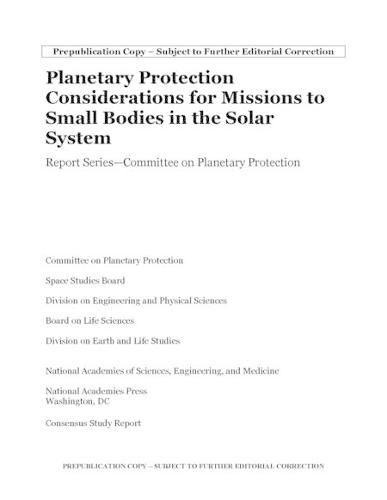Readings Newsletter
Become a Readings Member to make your shopping experience even easier.
Sign in or sign up for free!
You’re not far away from qualifying for FREE standard shipping within Australia
You’ve qualified for FREE standard shipping within Australia
The cart is loading…






The ultimate goal of planetary protection for outbound missions is to prevent harmful contamination that would inhibit future measurements designed to search for evidence of the existence or evolution of extraterrestrial life. Preventing harmful contamination is achieved by following specific guidelines based on existing scientific knowledge about the destination and the type of mission. This report responds to NASA's request for a study on planetary protection categorization of missions to small bodies, including whether there are particular populations of small bodies for which contamination of one object in the population would not be likely to have a tangible effect on the opportunities for scientific investigation using other objects in the population. In addressing NASA's request, the authoring committee considered surface composition of target bodies and their importance for prebiotic chemistry, along with size of the small-body populations, the current state of knowledge on the types of objects, the likelihood of a future scientific mission returning to any specific object, active object surface processes, and the size.
Table of Contents
Front Matter Executive Summary 1 Introduction 2 Small Bodies: Background and Considerations 3 Criteria for Planetary Protection Categorization of Small Body Missions 4 Implications of Planetary Protection Category I Versus Category II for Small Body Missions 5 Planetary Protection, Small Solar System Bodies, and Commercial Space Activities Appendixes Appendix A: Statement of Task Appendix B: COSPAR Planetary Protection Requirements for Category I and Category II Missions Appendix C: Acronyms and Abbreviations Appendix D: Committee and Staff Biographies
$9.00 standard shipping within Australia
FREE standard shipping within Australia for orders over $100.00
Express & International shipping calculated at checkout
The ultimate goal of planetary protection for outbound missions is to prevent harmful contamination that would inhibit future measurements designed to search for evidence of the existence or evolution of extraterrestrial life. Preventing harmful contamination is achieved by following specific guidelines based on existing scientific knowledge about the destination and the type of mission. This report responds to NASA's request for a study on planetary protection categorization of missions to small bodies, including whether there are particular populations of small bodies for which contamination of one object in the population would not be likely to have a tangible effect on the opportunities for scientific investigation using other objects in the population. In addressing NASA's request, the authoring committee considered surface composition of target bodies and their importance for prebiotic chemistry, along with size of the small-body populations, the current state of knowledge on the types of objects, the likelihood of a future scientific mission returning to any specific object, active object surface processes, and the size.
Table of Contents
Front Matter Executive Summary 1 Introduction 2 Small Bodies: Background and Considerations 3 Criteria for Planetary Protection Categorization of Small Body Missions 4 Implications of Planetary Protection Category I Versus Category II for Small Body Missions 5 Planetary Protection, Small Solar System Bodies, and Commercial Space Activities Appendixes Appendix A: Statement of Task Appendix B: COSPAR Planetary Protection Requirements for Category I and Category II Missions Appendix C: Acronyms and Abbreviations Appendix D: Committee and Staff Biographies